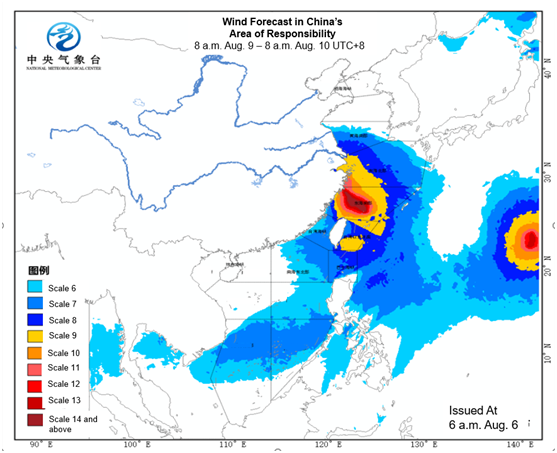LP 29/2019 Safety Precautions To Be Taken as Super Typhoon Lekima Approaches
Typhoon Emergency Alert
China Meteorological Administration (CMA) released warning of this year’s ninth typhoon Lekima on 10a.m. August 9. With its center located near 26.7°N, 123.1°E, 255 kilometers northwest of Wenling, Zhejiang province, Lekima has a minimum air pressure of 920 hectopascals and a maximum intensity registered scale 17 (58 m/s).
Radius of over 30 knot winds – 320 kilometers northeast, 300 kilometers northwest and 380 kilometers elsewhere;
Radius of over 50 knot winds – 100 kilometers;
Radius of over 70 knot winds – 40 kilometers.
Lekima is projected to move north by west direction at the speed of 15 km/h and will make landfall in coastal regions of central-northern Zhejiang in the daytime of August 10. It may strike as a strong or a super typhoon with a scale 14-16 intensity and will weaken subsequently as it moves northwards.

Typhoon Season Precautions
With super typhoon approaching, shipowners that may be affected are advised to take precautionary measures as listed below, also referring to CPI previous circular – LP 28/2018 Six Typhoon Readiness Advices to Keep you Safe.
1. Try to stay away from the typhoon by observing its track and evaluating the intensity of storms off the coast.
2. Try not to take berth at ports as steel wires may be worn off in swells despite their resistance. Once the mooring lines are broken, not only the vessel, but also port facilities will be damaged in collision with the vessel, and there’s also risks of a fallen shore crane.
3. Choose carefully the place to drop anchor – secured and sheltered anchorages with firm holding ground and sufficient depth of water, located away from aquafarms.
4. As one anchor may not suffice during a typhoon, shipmasters are advised to set two anchors at the same point and get the main engine ready in advance.
5. Wait in appropriate waters if taking berth is not an option until the situation is clear.
6. Make sure all watertight doors and windows are closed, all cargoes and stores are securely lashed down.
7. All moving equipment should be properly fixed or moved to storeroom beforehand.
8. Switch off the ventilation system, close the hatch covers and check the cargo holds for water tightness.
9. Ballast the vessel according to the draft to reduce its exposure in the storm. Be careful with the situation of dragging anchors and engine problems when there’s no sufficient stabilizing weight.
10. Vessels carrying cargoes that may liquefy like nickel ore should be kept away from the typhoon. If deviation is not possible, the ballast tank, pipelines and valves should be ready for immediate use once the cargoes are liquefied.
11. A safe practice meeting should be convened by the master in advance. Irrelevant personnel should be restricted to the accommodation. Assign more men at the deck and the engine room for watchkeeping and make sure the main engine, the steering gear and the mooring equipment are ready for use.
For further consultation, please contact your manager at the Club.
